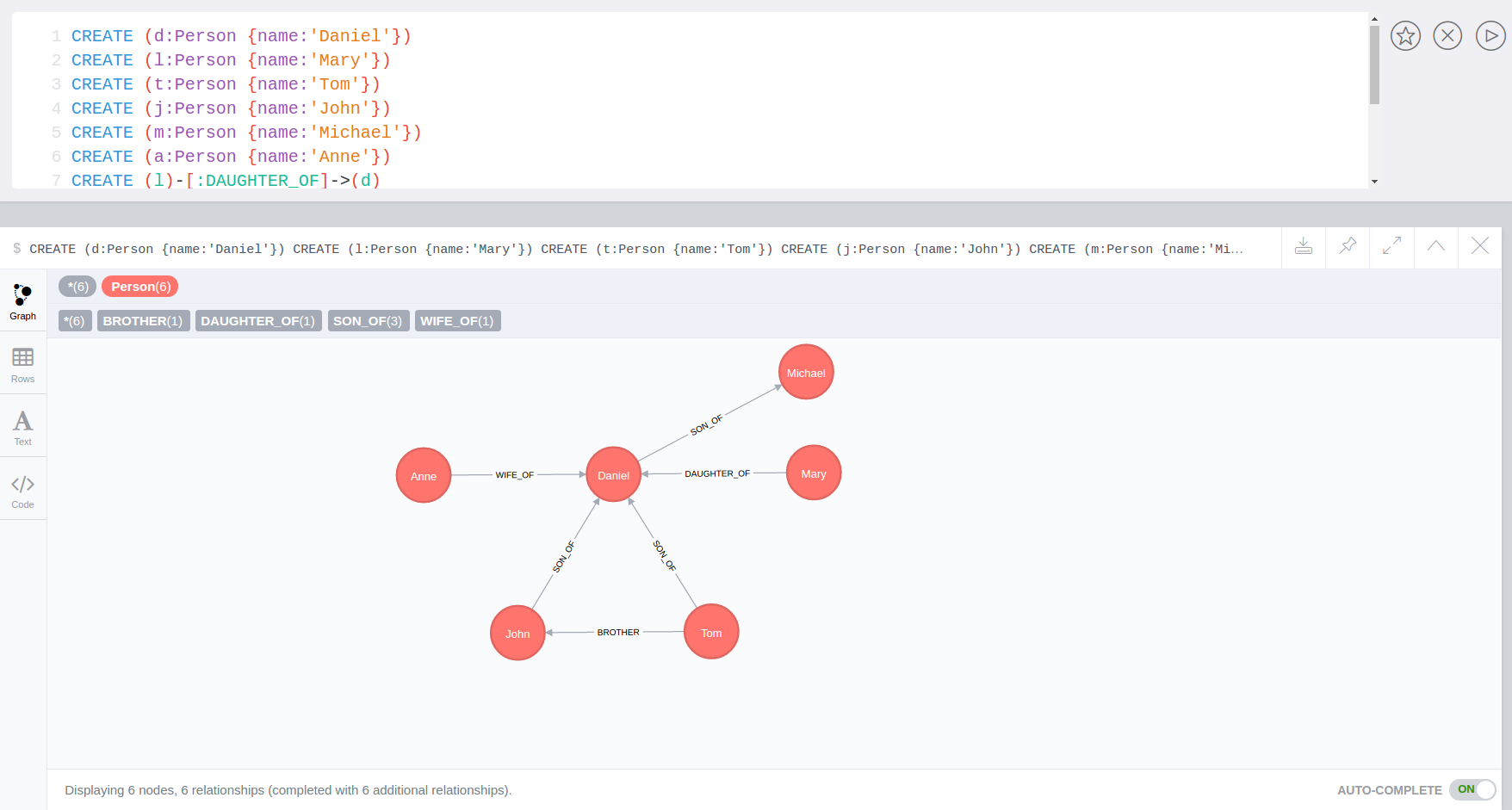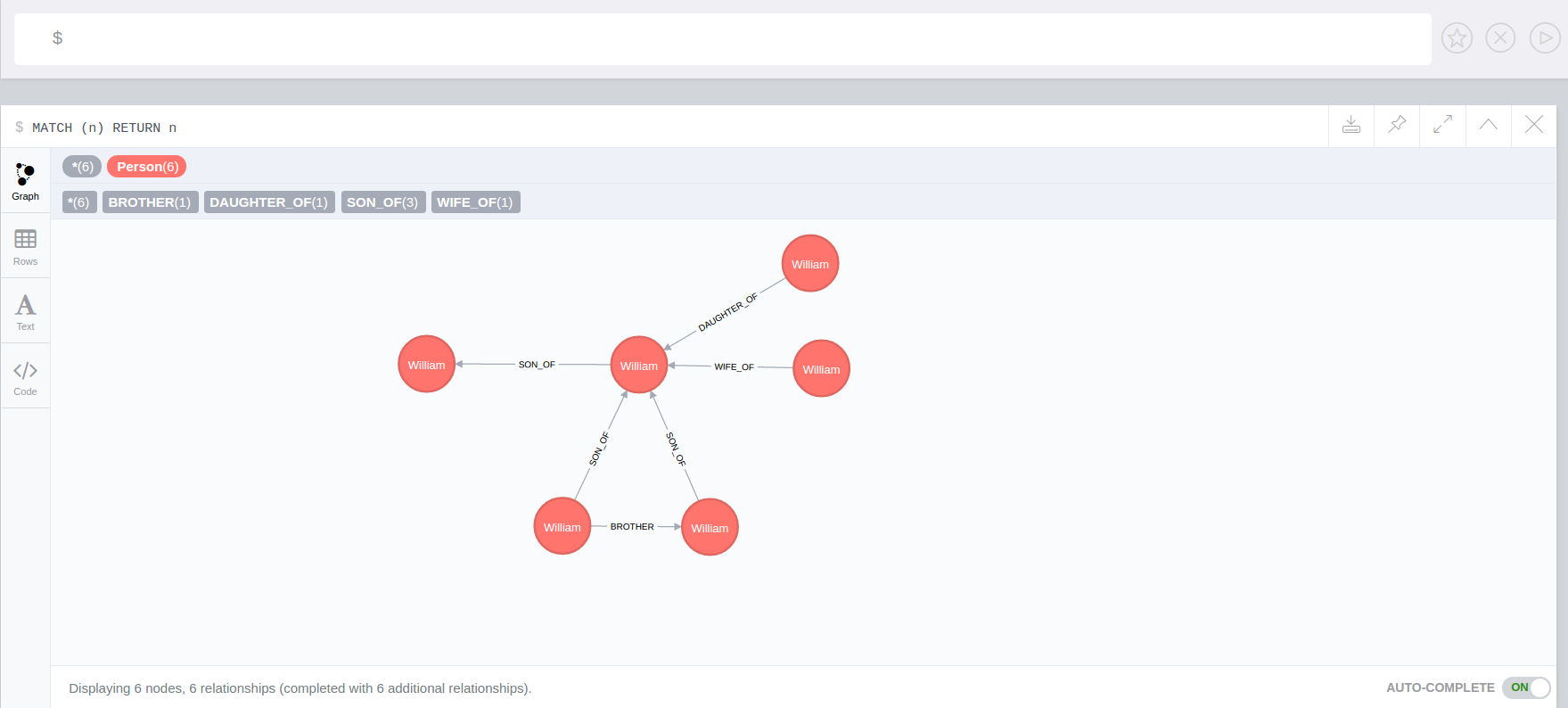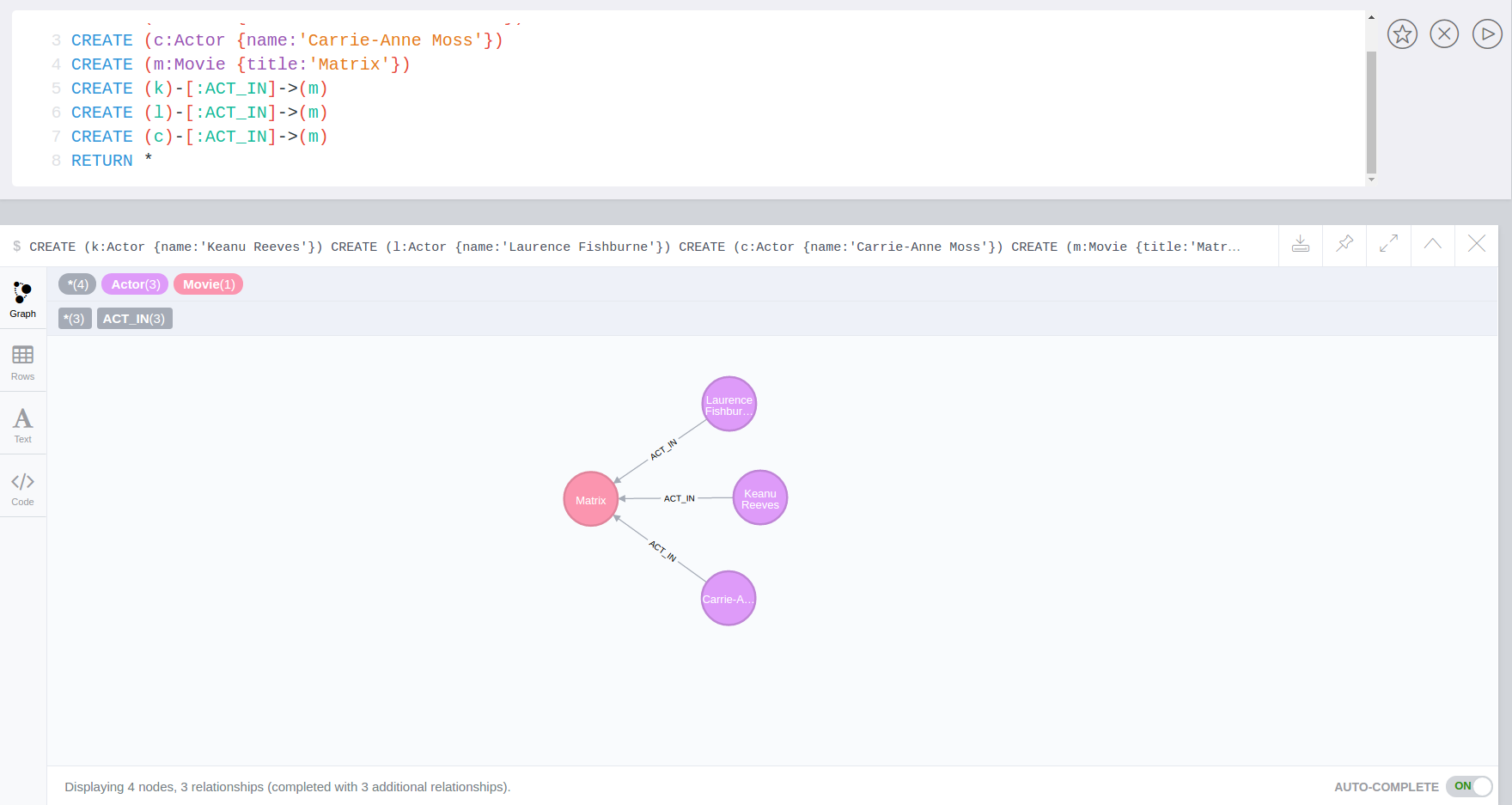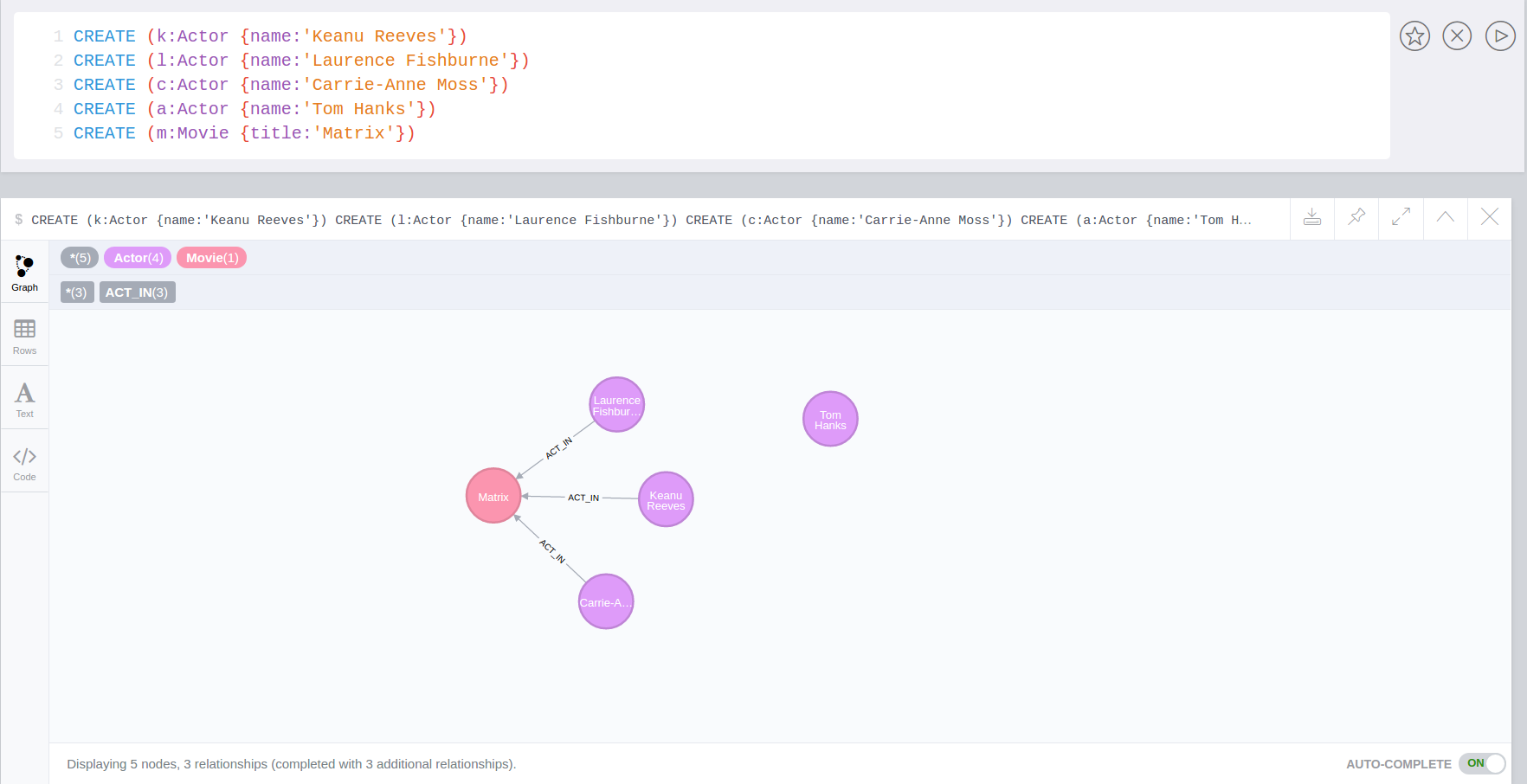Triggers
In a trigger you register Cypher statements that are called when data in Neo4j is changed (created, updated, deleted). You can run them before or after commit.
Enable apoc.trigger.enabled=true in $NEO4J_HOME/conf/apoc.conf first.
|
add a trigger statement under a name,
in the statement you can use |
|
remove previously added trigger, returns trigger information |
|
removes all previously added triggers , returns trigger information |
|
update and list all installed triggers |
|
it pauses the trigger |
|
it resumes the paused trigger |
The transaction data from Neo4j is turned into appropriate data structures to be consumed as parameters to your statement, i.e. $createdNodes.
The parameters available are:
| Statement | Description |
|---|---|
transactionId |
returns the id of the transaction |
commitTime |
return the date of the transaction in milliseconds |
createdNodes |
when a node is created our trigger fires (list of nodes) |
createdRelationships |
when a relationship is created our trigger fires (list of relationships) |
deletedNodes |
when a node is deleted our trigger fires (list of nodes) |
deletedRelationships |
when a relationship is deleted our trigger fires (list of relationships) |
removedLabels |
when a label is removed our trigger fires (map of label to list of nodes) |
removedNodeProperties |
when a properties of node is removed our trigger fires (map of key to list of map of key,old,node) |
removedRelationshipProperties |
when a properties of relationship is removed our trigger fires (map of key to list of map of key,old,relationship) |
assignedLabels |
when a labes is assigned our trigger fires (map of label to list of nodes) |
assignedNodeProperties |
when node property is assigned our trigger fires (map of key to list of map of key,old,new,node) |
assignedRelationshipProperties |
when relationship property is assigned our trigger fires (map of key to list of map of key,old,new,relationship) |
metaData |
a map containing the metadata of that transaction. Transaction meta data can be set on client side e.g. via https://neo4j.com/docs/api/java-driver/current/org/neo4j/driver/TransactionConfig.html#metadata-- |
You can use these helper functions to extract nodes or relationships by label/relationship-type or updated property key.
|
function to filter entries by label, to be used within a trigger statement with |
|
function to filter propertyEntries by property-key, to be used within a trigger statement with $assignedNode/RelationshipProperties and $removedNode/RelationshipProperties. Returns [{old,[new],key,node,relationship}] |
Triggers Examples
We could add a trigger that when is added a specific property on a node, that property is added to all the nodes connected to this node
Dataset
CREATE (d:Person {name:'Daniel', surname: 'Craig'})
CREATE (l:Person {name:'Mary', age: 47})
CREATE (t:Person {name:'Tom'})
CREATE (j:Person {name:'John'})
CREATE (m:Person {name:'Michael'})
CREATE (a:Person {name:'Anne'})
CREATE (l)-[:DAUGHTER_OF]->(d)
CREATE (t)-[:SON_OF]->(d)
CREATE (t)-[:BROTHER]->(j)
CREATE (a)-[:WIFE_OF]->(d)
CREATE (d)-[:SON_OF]->(m)
CREATE (j)-[:SON_OF]->(d)
With the above dataset, if we add a trigger and we execute for example, MATCH (n:Person) WHERE n.name IN ['Daniel', 'Mary'] SET n.age=55, n.surname='Quinn',
the $assignedNodeProperties which can be used in the trigger statement,
will be as follows (where NODE(1) is (:Person {name: 'Daniel'}), and NODE(2) is (:Person {name: 'Mary'})):
{
age: [{
node : NODE(1),
new: 55,
old: null,
key: "age"
},
{
node: NODE(2),
new: 55,
old: 47,
key: "age"
}],
surname: [{
node: NODE(1),
new: "Quinn",
old: "Craig",
key: "surname"
},
{
node: NODE(2),
new: "Quinn",
old: null,
key: "surname"
}]
}As we can see, the result is a map of list, where the keys are the assigned properties, and the values are a list of entities involved.
Every element of a list have the node itself, the new value of the changed properties, the old value (or null if the property didn’t exist) and the key with the property name.
The $removedNodeProperties parameter has the same structure and logic (of course, in this case new values will be always null).
Same thing regarding assignedRelationshipProperties and removedRelationshipProperties,
with the only difference that instead of node: NODE(n) key, we’ll have relationship: RELATIONSHIP(n).
For example, if we want to create a trigger that at every set, update 2 property "time" and "lasts" with the current date and the property updated, we can do:
CALL apoc.trigger.add('setLastUpdate',
'UNWIND keys($assignedNodeProperties) as k
UNWIND $assignedNodeProperties[k] AS map
with map.node as node, collect(map.key) as propList
match (n) where id(n) = id(node)
where not "lasts" in propList // to prevent loops
SET n.time = date(), n.lasts = propList', {phase:'afterAsync'});In the example above, we put match (n) where id(n) = id(node) to demonstrate that the we pull the node by id into parameters.
Anyway, we can get rid off this one and change last row with SET node.time = date(), node.lasts = propList.
Note that we have to put the clause where not "lasts" in propList to prevent infinite cascade SET.
Then, we can execute:
MATCH (n:Person {name: 'Daniel'}) set n.age = 123, n.country = 'Italy'Executing
MATCH (n:Person {name: 'Daniel'}) return nwe can see the property time with the today’s date, and lasts=['country','age'].
So when we add the surname property on a node, it’s added to all the nodes connected (in this case one level deep)
MATCH (d:Person {name:'Daniel'})
SET d.surname = 'William'Now we add the trigger using apoc.trigger.propertiesByKey on the surname property
CALL apoc.trigger.add('setAllConnectedNodes','UNWIND apoc.trigger.propertiesByKey($assignedNodeProperties,"surname") as prop
WITH prop.node as n
MATCH(n)-[]-(a)
SET a.surname = n.surname', {phase:'after'});So when we add the surname property on a node, it’s added to all the nodes connected (in this case one level deep)
MATCH (d:Person {name:'Daniel'})
SET d.surname = 'William'
The surname property is add/change on all related nodes
Dataset
CREATE (k:Actor {name:'Keanu Reeves'})
CREATE (l:Actor {name:'Laurence Fishburne'})
CREATE (c:Actor {name:'Carrie-Anne Moss'})
CREATE (m:Movie {title:'Matrix'})
CREATE (k)-[:ACT_IN]->(m)
CREATE (l)-[:ACT_IN]->(m)
CREATE (c)-[:ACT_IN]->(m)
We add a trigger using apoc.trigger.nodesByLabel that when the label Actor of a node is removed, update all labels Actor with Person
CALL apoc.trigger.add('updateLabels',"UNWIND apoc.trigger.nodesByLabel($removedLabels,'Actor') AS node
MATCH (n:Actor)
REMOVE n:Actor SET n:Person SET node:Person", {phase:'before'})MATCH(k:Actor {name:'Keanu Reeves'})
REMOVE k:Actor
We can add a trigger that connect every new node with label Actor and as name property a specific value
CALL apoc.trigger.add('create-rel-new-node',"UNWIND $createdNodes AS n
MATCH (m:Movie {title:'Matrix'})
WHERE n:Actor AND n.name IN ['Keanu Reeves','Laurence Fishburne','Carrie-Anne Moss']
CREATE (n)-[:ACT_IN]->(m)", {phase:'before'})CREATE (k:Actor {name:'Keanu Reeves'})
CREATE (l:Actor {name:'Laurence Fishburne'})
CREATE (c:Actor {name:'Carrie-Anne Moss'})
CREATE (a:Actor {name:'Tom Hanks'})
CREATE (m:Movie {title:'Matrix'})
Generally, is recommended to use afterAsync phase, to prevent some annoying transaction locks.
For example, given this trigger:
CALL apoc.trigger.add('lockTriggerTest1','UNWIND apoc.trigger.propertiesByKey($assignedNodeProperties,"name") as prop
WITH prop.node as n
CREATE (z:AnotherNode {myId: id(n)})
CREATE (n)-[:GENERATED]->(z)',
{phase:'after'});if we execute:
MATCH (n:Person {name: 'John'}) set n.name = 'Jack'the query will remain pending indefinitely.
To solve this, we can use {phase:'afterAsync'}
We have the possibility to pause a trigger without remove it, if we will need it in the future

When you need again of a trigger paused

For this example, we would like that all the reference node properties are of type STRING
CALL apoc.trigger.add("forceStringType",
"UNWIND apoc.trigger.propertiesByKey($assignedNodeProperties, 'reference') AS prop
CALL apoc.util.validate(apoc.meta.type(prop) <> 'STRING', 'expected string property type, got %s', [apoc.meta.type(prop)]) RETURN null", {phase:'before'})CREATE (a:Node) SET a.reference = 1
Neo.ClientError.Transaction.TransactionHookFailedWe can pass as a 4th parameter, a {params: {parameterMaps}} to insert additional parameters.
CALL apoc.trigger.add('timeParams','UNWIND $createdNodes AS n SET n.time = $time', {}, {params: {time: timestamp()}});CALL apoc.trigger.add('timestamp','UNWIND $createdNodes AS n SET n.ts = timestamp()', {});
CALL apoc.trigger.add('lowercase','UNWIND $createdNodes AS n SET n.id = toLower(n.name)', {});
CALL apoc.trigger.add('txInfo', 'UNWIND $createdNodes AS n SET n.txId = $transactionId, n.txTime = $commitTime', {phase:'after'});
CALL apoc.trigger.add('count-removed-rels','MATCH (c:Counter) SET c.count = c.count + size([r IN $deletedRelationships WHERE type(r) = "X"])', {})
CALL apoc.trigger.add('lowercase-by-label','UNWIND apoc.trigger.nodesByLabel($assignedLabels,"Person") AS n SET n.id = toLower(n.name)', {})
|
Description |
|
The trigger will be activate right |
|
The trigger will be activate right after the |
|
The trigger will be activate right |
|
The trigger will be activate right |
Export metadata
|
To import triggers in another database (for example after a |